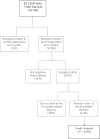The effect of maternity leave length and time of return to work on breastfeeding
- PMID: 21624878
- PMCID: PMC3387873
- DOI: 10.1542/peds.2010-0459
The effect of maternity leave length and time of return to work on breastfeeding
Abstract
Objective: We investigated the effect of maternity leave length and time of first return to work on breastfeeding.
Methods: Data were from the Early Childhood Longitudinal Study-Birth Cohort. Restricting our sample to singletons whose biological mothers were the respondents at the 9-month interview and worked in the 12 months before delivery (N = 6150), we classified the length of total maternity leave (weeks) as 1 to 6, 7 to 12, ≥ 13, and did not take; paid maternity leave (weeks) as 0, 1 to 6, ≥ 7, and did not take; and time of return to work postpartum (weeks) as 1 to 6, 7 to 12, ≥ 13, and not yet returned. Analyses included χ(2) tests and multiple logistic regressions.
Results: In our study population, 69.4% initiated breastfeeding with positive variation by both total and paid maternity leave length, and time of return to work. In adjusted analyses, neither total nor paid maternity leave length had any impact on breastfeeding initiation or duration. Compared with those returning to work within 1 to 6 weeks, women who had not yet returned to work had a greater odds of initiating breastfeeding (odds ratio [OR]: 1.46 [1.08-1.97]; risk ratios [RR]: 1.13 [1.03-1.22]), continuing any breastfeeding beyond 6 months (OR: 1.41 [0.87-2.27]; RR: 1.25 [0.91-1.61]), and predominant breastfeeding beyond 3 months (OR: 2.01 [1.06-3.80]; RR: 1.70 [1.05-2.53]). Women who returned to work at or after 13 weeks postpartum had higher odds of predominantly breastfeeding beyond 3 months (OR: 2.54 [1.51-4.27]; RR: 1.99 [1.38-2.69]).
Conclusion: If new mothers delay their time of return to work, then duration of breastfeeding among US mothers may lengthen.
Figures
References
-
- Pan American Health Organization Quantifying the Benefits of Breastfeeding: A Summary of the Evidence. Washington, DC: Pan American Health Organization; June 2002
-
- Gartner LM, Morton J, Lawrence RA, et al. Breastfeeding and the use of human milk. Pediatrics. 2005;115(2):496–506 - PubMed
-
- Committee on Health Care for Underserved Women, American College of Obstetricians and Gynecologists ACOG Committee Opinion No. 361: Breastfeeding: maternal and infant aspects. Obstet Gynecol. 2007;109(2 pt 1):479–480 - PubMed
-
- James DC, Dobson B. American Dietetic Association. Position of the American Dietetic Association: promoting and supporting breastfeeding. J Am Diet Assoc. 2005;105(5):810–818 - PubMed
-
- Centers for Disease Control and Prevention Breastfeeding Among US Children Born 1999–2005, CDC National Immunization Survey. Atlanta, GA: Centers for Disease Control and Prevention; 2008


